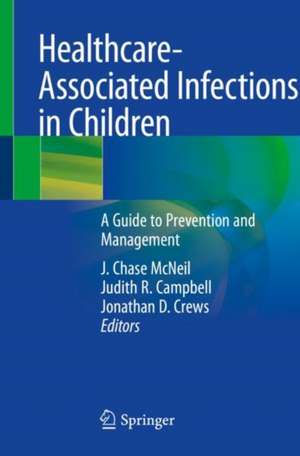Healthcare-Associated Infections in Children: A Guide to Prevention and Management
Editat de J. Chase McNeil, Judith R. Campbell, Jonathan D. Crewsen Limba Engleză Paperback – 8 noi 2018
Preț: 656.28 lei
Preț vechi: 690.83 lei
-5% Nou
Puncte Express: 984
Preț estimativ în valută:
125.58€ • 131.47$ • 103.91£
125.58€ • 131.47$ • 103.91£
Carte tipărită la comandă
Livrare economică 05-19 aprilie
Preluare comenzi: 021 569.72.76
Specificații
ISBN-13: 9783319981215
ISBN-10: 3319981218
Pagini: 294
Ilustrații: XII, 351 p. 19 illus., 11 illus. in color.
Dimensiuni: 155 x 235 mm
Greutate: 0.51 kg
Ediția:1st ed. 2019
Editura: Springer International Publishing
Colecția Springer
Locul publicării:Cham, Switzerland
ISBN-10: 3319981218
Pagini: 294
Ilustrații: XII, 351 p. 19 illus., 11 illus. in color.
Dimensiuni: 155 x 235 mm
Greutate: 0.51 kg
Ediția:1st ed. 2019
Editura: Springer International Publishing
Colecția Springer
Locul publicării:Cham, Switzerland
Cuprins
Section 1. Overview of Infection Control and Prevention.- Chapter 1. Basic Principles of Infection Control.- Chapter 2. The Role of the Environment and Colonization in Healthcare Associated Infections.- Chapter 3. The Role of Antimicrobial Stewardship.- Chapter 4: Infection Control and the Need for Family/Child Centered Care.- Section 2. Major Healthcare-Associated Infection Syndromes.- Chapter 5: Fever in the Hospitalized or Critically Ill Child.- Chapter 6: Central Line-Associated Bloodstream Infections (CLABSI).- Chapter 7: Ventilator Associated Pneumonias.- Chapter 8: Infections Complicating Abdominal Surgery Procedures.- Chapter 9: Infections Complicating Orthopedic Surgery and Implants.- Chapter 10: Infections Complicating Neurosurgical Procedures/Devices.- Chapter 11: Infections Complicating Cardiothoracic Surgery and Cardiac Devices.- Chapter 12: Healthcare-Associated Gastrointestinal Infections.- Chapter 13: Healthcare-associated Urinary Tract Infections.- Chapter 14: Healthcare Associated Viral Infections: Considerations for Nosocomial Transmission and Infection Control.- Section 3. Infections in Vulnerable Hosts.- Chapter 15: Healthcare-associated infections in the NICU: a brief review.- Chapter 16: Infection Prevention in pediatric oncology and hematopoietic stem cell transplant recipients.- Chapter 17: Nosocomial Infections in Pediatric Solid Organ Transplantation.- Chapter 18: Infections in Pediatric Patients with End Stage Renal Disease.
Recenzii
“This book provides detailed information for physicians and others caring for children at risk for, or infected with, healthcare-associated infections. The format ensures that information is readily accessible, readable, and locatable either via chapter heading or index. The book delivers comprehensive information on a broad base of topics within the field of infectious disease and infection prevention, making it relevant for many disciplines managing hospitalized children.” (Kari A Simonsen, Doody's Book Reviews, April 19, 2019)
Notă biografică
Jonathon Chase McNeil, MD, BS
Assistant Professor
Department of Pediatrics
Section of Infectious Disease
Baylor College of Medicine
Texas Children’s Hospital
1102 Bates Street, Suite 1150
Houston, TX 77030
Judith R. Campbell, MD
Professor
Department of Pediatrics
Section of Infectious Disease
Baylor College of Medicine
Texas Children’s Hospital
1102 Bates Street
Houston, TX 77030-2399, USA
Jonathan Crews MD, MS
Assistant Professor
Pediatric Infectious Diseases
Baylor College of Medicine
The Children’s Hospital of San Antonio
315 N. San Saba, Suite 1003
San Antonio, TX 78207
Assistant Professor
Department of Pediatrics
Section of Infectious Disease
Baylor College of Medicine
Texas Children’s Hospital
1102 Bates Street, Suite 1150
Houston, TX 77030
Judith R. Campbell, MD
Professor
Department of Pediatrics
Section of Infectious Disease
Baylor College of Medicine
Texas Children’s Hospital
1102 Bates Street
Houston, TX 77030-2399, USA
Jonathan Crews MD, MS
Assistant Professor
Pediatric Infectious Diseases
Baylor College of Medicine
The Children’s Hospital of San Antonio
315 N. San Saba, Suite 1003
San Antonio, TX 78207
Textul de pe ultima copertă
This book focuses on the epidemiology, diagnosis and management of Healthcare-Associated Infections (HAIs) in children. Unlike similar texts, this book details both the general principles involved in HAIs and infection prevention and also provides a problem-oriented approach, more precisely meeting the needs of a clinician at the bedside. Importantly, included in this text are discussions on medical device-related infections in children. The book is divided into three principle sections: 1) basic principles of infection control and prevention, 2) major infectious syndromes and 3) infections in vulnerable hosts. Each chapter covers the epidemiology, microbiology, clinical features, diagnosis, medical management and prevention of the disease entity of interest. Written by experts in the field, chapters are evidenced-based, drawing from the published medical literature as well as from clinical practice guidelines. Richly illustrated with tables, figures and algorithms, the book is designed to assist in the evaluation and management of these often complex patients.
Healthcare-Associated Infections in Children is a valuable resource for infectious disease specialists, intensivists, neonatologists, surgeons, oncologists, infection preventionists, hospitalists, nurses, and all medical professionals treating children who are susceptible to HAIs.
Healthcare-Associated Infections in Children is a valuable resource for infectious disease specialists, intensivists, neonatologists, surgeons, oncologists, infection preventionists, hospitalists, nurses, and all medical professionals treating children who are susceptible to HAIs.
Caracteristici
Includes basic principles from a problem- and evidence-based approach Richly illustrated with tables, figures and algorithms Written by experts in multiple medical fields, including infectious diseases and pediatrics
